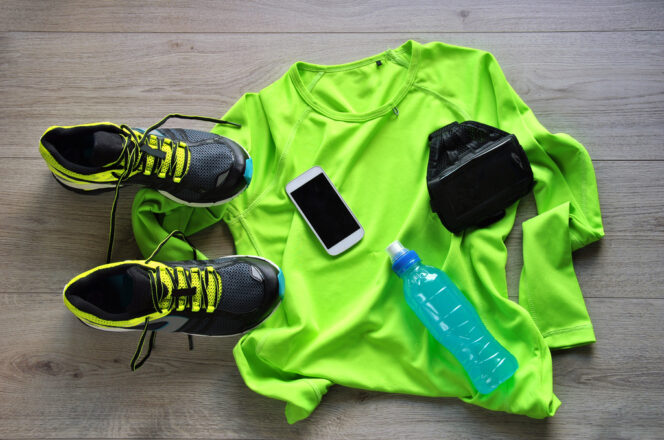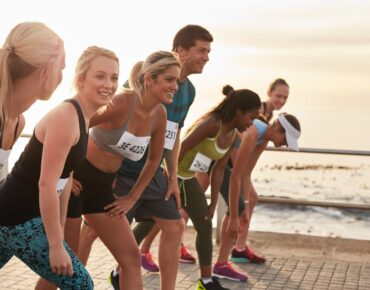Heading out for a run in a cotton hoodie and an old pair of shoes? Not so fast.
Wearing the right clothes when running can make your runs more comfortable. It can reduce the risk of injury and improve your running performance.
Read on to find out what to wear for running. We’ll be talking about running clothes and all the running gear and accessories you may need.
In This Article:
What to Wear Running
Running increases your body temperature and makes you sweat. The best running clothes are layered, moisture-wicking, and provide sun protection.
The best running outfit materials include polyester, nylon, and merino wool, as they are moisture-wicking and quick-drying.
In colder weather, you can easily remove extra layers as you heat up. Think of a light windproof running jacket you can tie around your waist.
Good to know: Merino wool can regulate temperature and help prevent bad odors.
You also want to wear running shoes that feel comfortable and provide good cushioning. Running accessories include sunglasses, hat, gloves, running vest, sports watch, or phone armband. Each of these can prove useful.
You may want to avoid dark, heat-absorbing colors in summer or white running clothes when doing a trail run. But other than that, you can color your run any way you want.
Other features you may want to consider when it comes to running clothing include:
- Compression. Running apparel can come with a snug fit to provide compression. This can increase blood flow, reduce water retention, and flush out by-products of exercise like lactic acid faster.
- Inner lining. Acting as underwear, this feature of running pants or shorts can wick moisture to prevent chafing.
- Mesh. Some tops have cooling mesh panels to help cool your underarms or back.
- Insulation. Insulated running costumes provide warmth with little added weight.
- Reflectivity. This running wear feature makes it safer to run in low-light conditions.
Running gear for women isn’t that much different from running gear for men. Women may choose to run in a singlet or sports bra. But other than that, it’s just a question of choosing a size that fits.
Tip: Make sure you feel comfortable in race clothing. Wear it during training before the big day.
These general guidelines aside, the answer to “What to wear when running?” depends on the weather.
Running Clothes: Dress My Run According to the Weather
As a runner, you have to adapt your running apparel to the weather. More than temperature, consider humidity, wind, and UV exposure levels. Let’s take a closer look at what to wear for running in any weather.
Clothes for warm-weather running
Running in summer comes with the temptation to ditch most clothes except your shorts and running shoes. But that’s not a good idea, especially if you’re going for a long run.
Sunburn is common among long-distance runners. A 2021 study of mountain marathon runners found that runners are at risk of sunburn despite protective measures like sunglasses, sunscreen, and protective clothing. Risk factors include younger age, light skin, and running more than three hours a day.
Running outfits with UV protection may not provide complete protection against sunburn, but they can help reduce the risk of it.
A survey of outdoor sports players found that only 20.2% of participants reported using adequate sunscreen. On the plus side, the study suggests that those who use sunscreen are more likely to apply it during sports and other outdoor activities.
The best jogging outfit in summer should include:
- Light moisture-wicking top, shirt, or sports bra
- Shorts or compression leggings for a long run
- Sunscreen
- Sunglasses with UV protection
- Visor, hat, or cap
- Light running shoes with mesh fabric
Tip: Don’t forget to take a water bottle with you.
What to wear when running in the winter cold
Some runners can tolerate colder temperatures better than others. But running in very cold weather puts every runner at risk of frostbite and hypothermia. The most effective way to prevent frostbite and hypothermia is to wear multiple layers of clothing. Running in snow can also present its own set of challenges.
The best runners’ clothing for cold weather includes:
- Long-sleeve compression top or shirt
- Waterproof padded jacket or vest (if it’s very cold)
- Insulated leggings
- Sunglasses with UV protection
- Headband or beanie
- Insulated gloves
- Running shoes with good grip or cleats
- Neoprene face mask, buff, or scarf to wrap around your face (reduces discomfort from inhaling cold, dry air)
Tip: On winter runs, wear 2–4 layers of clothing depending on how cold it gets.
Extreme condition running clothes and gear
Running in sweltering weather, biting cold temperatures, or following a very long and muddy trail? Here are some of the best running clothes for men and women during extreme conditions.
86ºF+ (30ºC+)
- Light-colored shorts with UV protection to avoid chafing
- Light-colored singlet, top, or t-shirt with mesh vent
- Compression socks from synthetic fibers
- Sunglasses with 100% UV protection
- Light-colored cap or hat
- Lightweight mesh running shoes
- Sweat-resistant SPF 50+ sunscreen
14ºF or lower (-10ºC or lower)
- Heavy jacket with insulation
- Long-sleeve merino wool shirt
- Merino wool top, shirt, or singlet
- Full compression tights
- Thermal leggings
- Compression socks
- Wraparound sunglasses (can also protect against the wind)
- Heavy mittens
- Merino wool beanie or cap
- Waterproof running shoes with traction cleats
Tip: Whether you’re running in good or extreme weather, don’t forget to take your ID with you. It can help in case of emergency.
Clothes for running in the rain
Light to moderate rain is no excuse to skip a run. So long as it’s not thundering and the wind isn’t bad, you can stick to your running plan.
The best running outfit for rainy weather includes:
- Lightweight waterproof hooded jacket
- Compression tights
- Non-slip running shoes
- Waterproof sports watch
Tip: Wear reflective gear if the weather affects visibility.
Running Shoes
A 2015 study investigated the link between running shoes and running injuries. According to the study, neither pronation nor impact forces seem to predict running injuries.
Researchers suggest that a good running shoe allows the foot to move in its natural path of movement. By doing so, it requires less muscle energy than a bad shoe. If a running shoe feels comfortable for you, it’s a good shoe.
Here are some other things to keep in mind when choosing the best running shoes:
- Add running cleats or another running traction device to your winter running shoes.
- In winter or on rainy days, wear running shoes made of waterproof, breathable fabric membranes like Gore-Tex.
- Feet swell when running, so pick a slightly larger size.
- Try your cold-weather running shoes with thick socks before buying them to make sure the fit is good.
- Avoid shoes with a hard and tight front, as they may give you black toenails.
Research indicates that changing running shoes often may increase the risk of foot and ankle injuries. This occurs because new shoes put more pressure on the plantar area that connects the heel bone to the base of the toes.
A safe approach is to wear new running shoes during mild physical activity first to break them in before taking them for a long run.
Other Running Gear and Accessories
Running accessories range from water bottles and carriers to sports watches. Here’s some of the best running gear you can add to your track outfit.
Technical socks
A 2019 study found that technical socks can prevent foot lesions and maintain a stable foot temperature even during low-difficulty, short-term activities.
Technical socks use breathable fabrics to draw sweat away from the skin. This helps keep your feet dry and comfortable.
Sports bra
A survey of 1,397 female runners at the 2012 London Marathon found that a sports bra is important during longer races but is not always used. It can be especially useful during vigorous activity and for women with larger breasts.
Compression garments
A 2018 study on male uphill runners found that medium-grade compression garments can improve running performance. It can also decrease muscle soreness after exercise. The best running gear for men and women includes compression garments.
Armband carrier
Your phone can be the perfect running companion with an app like Joggo on it that also works on smartwatches like the Apple Watch. Still, running with your phone in your hand can be uncomfortable. An armband carrier can be more comfortable than running with your phone in a pocket.
Sports watches or fitness bracelets
A sports watch or fitness bracelet can help you track distance and pace without the added weight of a phone. Research from 2017 suggests younger, less experienced long-distance runners are more likely to use mobile apps.
More experienced and involved runners, by contrast, are more likely to use sports watches.
Water bottle or carrier
Hydration is crucial during long races. A water bottle or carrier ensures you stay hydrated every step of the way.
You can choose between a handheld water bottle, belt carrier, backpack water carrier, or vest water carrier. During winter, choose an insulated bottle.
Sun protection
Waterproof sunscreen with an SPF over 30 is the first line of defense against harmful UV rays. Consider running garments with UV protection, including tops, shorts, and buff. And don’t forget your hat, cap, and UV-blocking sunglasses.
What Not to Wear for a Run
Running in the wrong clothes leads to moisture accumulating in the fabrics. This can disrupt your thermal balance and slow you down.
Sweat absorption differs not only based on the material of the clothing but also on different clothing zones. For example, a t-shirt’s upper and medial zones tend to absorb more sweat than the lateral sides.
So what should you not wear for a run? Let’s find out.
Heavy layers
Winter run ahead of you? Can you run it in thick layers? Not a good idea. Thick layers make your body overheat when running. Then, when you take it off, you’ll get all chilled. Avoid sweaters, thick shirts, or very thick socks.
Cotton garments
Once it gets wet, cotton stays wet. It doesn’t wick away moisture from your skin. Rather, it becomes saturated with it and takes a long time to dry. It also promotes chafing.
Whether you run in summer or winter, wearing cotton is not a good idea. Don’t run in sweatpants or sweatshirts.
Worn-out shoes
Worn-out running shoes lose the ability to provide cushioning and absorb shocks. They also lose stability. Studies show they can increase the risk of ankle, knee, and leg injuries.
Consider having two or more pairs of running shoes and rotating them. A good rule of thumb is to replace your running shoes every 300–400 miles or up to 500 miles if they show no signs of wear and tear.
Takeaways
You don’t have to think too much about what to wear for running. Here are the key things to remember:
- Run in lightweight and moisture-wicking clothes made from polyester, nylon, or merino wool.
- Merino wool is a great cold-weather fabric for runners.
- Avoid cotton and other moisture-absorbing fabrics.
- Build warmth by putting together 2–4 layers of clothing.
- Wear waterproof sunscreen and UV-protection clothing in summer.
- Break in your running shoes before taking them for a long run.














